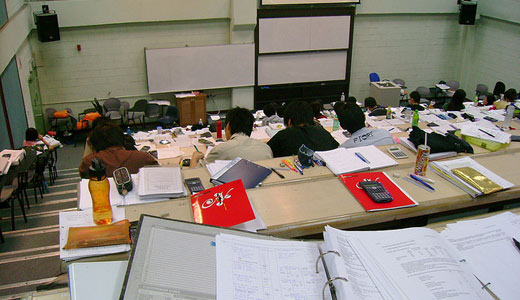
The American Federation of Teachers recently highlighted the tenuous employment and poor compensation of part-time college teachers in an article titled: “New report blasts working conditions of adjunct faculty.“
The article spotlights findings of two recent reports. In the first, a survey of 500 adjunct faculty found they are frequently hired at the last minute for courses they have little time to prepare for, with little or no support from the institution. They rarely have opportunities for professional development or chances to share in the collegial culture of education.
The second report, “Dismantling the Professoriate,” paints a bleak portrait of the poverty-level wages and lack of professional support for adjunct faculty, who often make significantly less per course than their full-time counterparts:
- “The median pay per course, standardized to a three-credit course, was $2,700 in fall 2010, and ranged from a low of $2,235 at two-year colleges to a high of $3,400 at four-year doctoral or research universities.
- “Part-time faculty respondents saw little, if any, wage premium based on their credentials.
- “Professional support was minimal for part-time faculty members’ work outside the classroom and for their inclusion in academic decision-making.”
Grassroots efforts are also drawing attention to the low pay, lack of benefits and lack of support in a field that has come to depend on the presence of a surplus of “freeway flyers,” as adjuncts are often called.
A “crowd-sourced” spreadsheet at adjunctproject.com lists data from part-time faculty all over the U.S., on wages, health benefits (or more commonly, lack thereof), access to institutional support, union membership and retirement.
Budget cuts are often blamed for the over-reliance on part-time adjuncts to handle the bulk of teaching. Budgets have indeed been slashed in education, but data shows at the same time, the non-teaching administrative sector has grown.
While college administrations often tout the fiscal advantages of using part-time faculty, they don’t apply the same logic to their own ranks. Between 1976 and 2005, part-time faculty rose from 31 percent to 48 percent, while part-time administrators declined from 4 percent to 3 percent.
College administrators’ salaries are several levels higher than the wages of adjunct teachers. Although full professors’ salaries may seem commensurate with those of administrators, salaries and wages for all teaching staff have not kept pace, even with rising tuition, as reported by the American Association of University Professors.
The AAUP says tuition rose much faster than full-time faculty salaries, with the greatest gap at public institutions, where tuition and fees grew by 72 percent, accounting for inflation, while professors’ salaries rose by less than 1 percent at doctoral and baccalaureate institutions and fell by over 5 percent at master’s universities.
Meanwhile, the AAUP says, between 2006-7 and 2010-11, median presidential salaries jumped by 9.8 percent, adjusted for inflation, while median full-time faculty salaries rose by less than 2 percent.”
In fact most adjuncts have been hired when universities were not facing budget cuts, the AAUP reported .
At the same time, colleges are increasingly turning toward corporate models and business culture. And corporations and businesses are taking more of a role in diverting public education funds intended for colleges, and instead directing them to private profit. Cheap and surplus labor is the model for an expanding bottom line in Wall Street-driven institutions and the same process has taken hold of our institutions of higher learning, especially in privatization at public universities.
Without tenure, adjuncts are among the first to be fired when cuts are on the table, just like temps and contract workers across many other fields. This can translate to depressed wages across the board for teaching staff, higher class loads for the remaining faculty (in some cases throwing teaching duties on “stipend” paid graduate students who make even less than adjuncts), and a decrease in dues in the teaching union locals, attacking their ability to fight educational austerity measures.
Slashing the teaching workforce in education does not cause the economy to grow or save the budgets of universities in the long run. Expanding wages and benefits and teaching opportunities for adjuncts would bring more regional prosperity, increasing the tax base and helping to grow available funds for education.
The political will must also be found to raise taxes on the wealthy and corporations, who benefit from the presence of public universities and a well-educated labor force. Full time and part time teaching staff must forge organized and unified fight-backs, to press universities to benefit the teaching staff who attract students to the school. Resisting the privatization of our public resources will also help reverse the trend of making education jobs poverty-level.
Adjuncts should not view themselves as “the expendables,” but as a workforce that now makes up the majority of higher education staff. If there is a union at your college, join it. If the adjuncts are not organized or not part of the existing union, press to become a part of the union or form an adjunct union.
Organization is the best weapon against capitalism, which has definitely entered the arena of higher education. The future of our working people, teachers and students alike, is at stake.
Photo: A college class, stock photo. Yee Ting // CC 2.0










